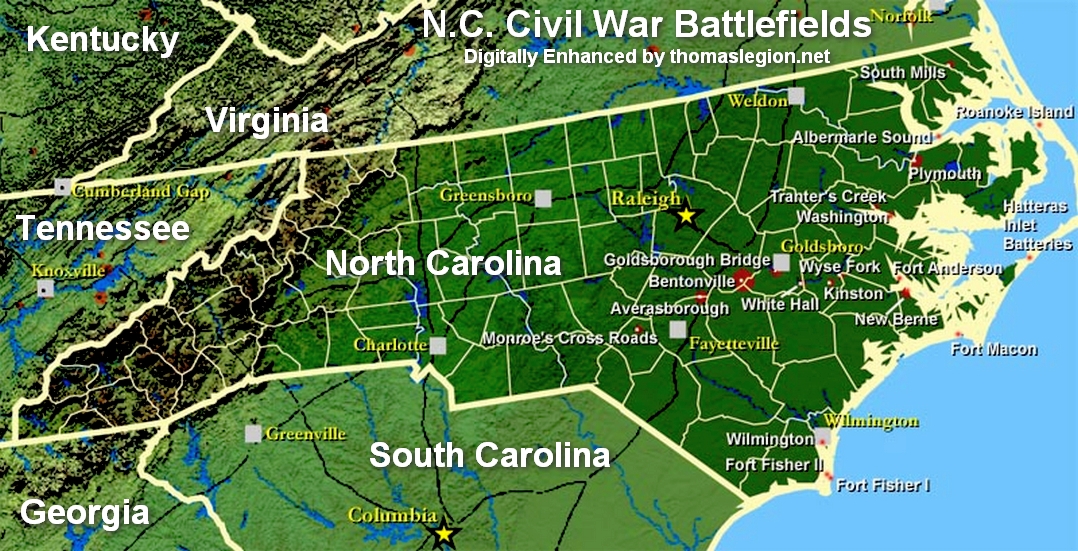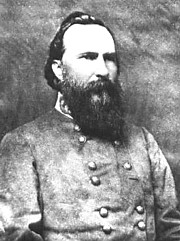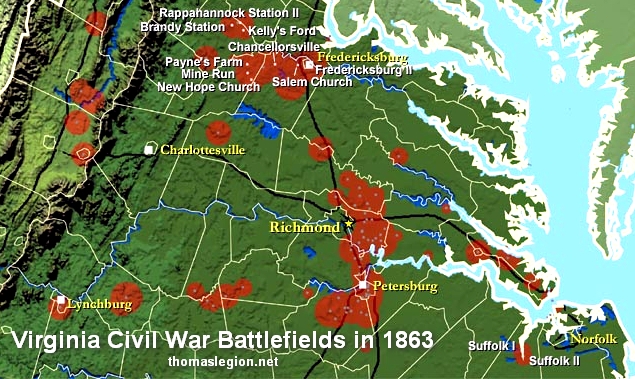|
In 1863, Lt. Gen. James Longstreet was placed in command of the Confederate Department of Virginia and North Carolina. Longstreet was given four
objectives: 1) protect Richmond, 2) support Robert E. Lee's Army of Northern Virginia,
3) forage and gather supplies for the Confederate armies, and 4) retake, or capture, the forts along the Virginia
and North Carolina Coast. "Longstreet's Tidewater Operations," which resulted in a series of battles, was designed to accomplish said
goals.
| Longstreet's Tidewater Operations Map |

|
| Longstreet's Tidewater Operations Map |
| General James Longstreet |

|
| (Library of Congress) |
| Longstreet's Tidewater Operations |

|
| Longstreet's Tidewater Operations |
Longstreet's Tidewater Operations [March-April
1863]
Battle of Norfleet House (aka
Suffolk)
Battle of Hill's Point (aka Suffolk)
Recommended Reading: The
Civil War in Coastal North Carolina (175 pages) (North Carolina Division of Archives and History). Description: From the drama of blockade-running to graphic descriptions of battles
on the state's islands and sounds, this book portrays the explosive events that took place in North Carolina's
coastal region during the Civil War. Topics discussed include the strategic importance of coastal North Carolina, Federal occupation of coastal areas, blockade-running, and the impact of
war on civilians along the Tar Heel coast.
Recommended Reading: Ironclads and Columbiads: The Coast
(The Civil War in North Carolina) (456 pages). Description: Ironclads and Columbiads covers some of the most
important battles and campaigns in the state. In January 1862, Union forces began in earnest to occupy crucial points on the
North Carolina coast. Within six months, Union army and
naval forces effectively controlled coastal North Carolina from the Virginia
line south to present-day Morehead City.
Continued below...
Union setbacks in Virginia, however, led to the withdrawal of many federal soldiers from North Carolina,
leaving only enough Union troops to hold a few coastal strongholds—the vital ports and railroad junctions. The South
during the Civil War, moreover, hotly contested the North’s ability to maintain its grip on these key coastal strongholds.
Recommended Reading: The Civil War in the Carolinas
(Hardcover). Description: Dan Morrill relates the experience
of two quite different states bound together in the defense of the Confederacy, using letters, diaries, memoirs, and reports.
He shows how the innovative operations of the Union army and navy along the coast and
in the bays and rivers of the Carolinas affected the general course of the war as well as
the daily lives of all Carolinians. He demonstrates the "total war" for North
Carolina's vital coastal railroads and ports. In the latter part of the war, he describes
how Sherman's operation cut out the heart of the last stronghold
of the South. Continued below...
The author
offers fascinating sketches of major and minor personalities, including the new president and state governors, Generals Lee,
Beauregard, Pickett, Sherman, D.H. Hill, and Joseph E. Johnston. Rebels and abolitionists, pacifists and unionists, slaves
and freed men and women, all influential, all placed in their context with clear-eyed precision. If he were wielding a needle
instead of a pen, his tapestry would offer us a complete picture of a people at war. Midwest Book Review: The Civil War in the Carolinas by civil war expert and historian
Dan Morrill (History Department, University of North Carolina at Charlotte, and Director of the Charlotte-Mecklenburg Historical
Society) is a dramatically presented and extensively researched survey and analysis of the impact the American Civil War had
upon the states of North Carolina and South Carolina, and the people who called these states their home. A meticulous, scholarly,
and thoroughly engaging examination of the details of history and the sweeping change that the war wrought for everyone, The
Civil War In The Carolinas is a welcome and informative addition to American Civil War Studies reference collections.
Recommended Reading: Storm
over Carolina: The Confederate Navy's Struggle for Eastern North Carolina. Description: The struggle for control of the eastern
waters of North Carolina during the War Between the States
was a bitter, painful, and sometimes humiliating one for the Confederate navy. No better example exists of the classic adage,
"Too little, too late." Burdened by the lack of adequate warships, construction facilities, and even ammunition, the
South's naval arm fought bravely and even recklessly to stem the tide of the Federal invasion of North
Carolina from the raging Atlantic. Storm
Over Carolina is the account of the Southern navy's struggle in North
Carolina waters and it is a saga of crushing defeats interspersed with moments of brilliant and even
spectacular victories. It is also the story of dogged Southern determination and incredible perseverance in the face
of overwhelming odds. Continued below...
For most of
the Civil War, the navigable portions of the Roanoke, Tar, Neuse, Chowan, and Pasquotank rivers were
occupied by Federal forces. The Albemarle and Pamlico sounds, as well as most of the coastal towns and counties, were also
under Union control. With the building of the river ironclads, the Confederate navy at last could strike a telling blow against
the invaders, but they were slowly overtaken by events elsewhere. With the war grinding to a close, the last Confederate vessel
in North Carolina waters was destroyed. William T. Sherman
was approaching from the south, Wilmington was lost, and the
Confederacy reeled as if from a mortal blow. For the Confederate navy, and even more so for the besieged citizens of eastern
North Carolina, these were stormy days indeed. Storm Over Carolina describes their story, their struggle, their history.
Recommended Reading: Civil War High Commands (Hardcover). Description: Based on nearly five decades of research,
this magisterial work is a biographical register and analysis of the people who most directly influenced the course of the
Civil War, its high commanders. Numbering 3,396, they include the presidents and their cabinet members, state governors, general
officers of the Union and Confederate armies (regular, provisional, volunteers, and militia),
and admirals and commodores of the two navies. Civil War High Commands will become a cornerstone reference work on
these personalities and the meaning of their commands, and on the Civil War itself. Errors of fact and interpretation concerning
the high commanders are legion in the Civil War literature, in reference works as well as in narrative accounts. Continued
below...
The present work brings together for the first time in one volume
the most reliable facts available, drawn from more than 1,000 sources and including the most recent research. The biographical
entries include complete names, birthplaces, important relatives, education, vocations, publications, military grades, wartime
assignments, wounds, captures, exchanges, paroles, honors, and place of death and interment. In addition to its main component, the biographies, the volume also includes a number of essays,
tables, and synopses designed to clarify previously obscure matters such as the definition of grades and ranks; the difference
between commissions in regular, provisional, volunteer, and militia services; the chronology of military laws and executive
decisions before, during, and after the war; and the geographical breakdown of command structures. The book is illustrated
with 84 new diagrams of all the insignias used throughout the war and with 129 portraits of the most important high commanders.
Recommended
Reading: American Civil War Fortifications (1): Coastal brick and stone forts (Fortress). Description: The 50 years before the American Civil War saw a boom in the construction
of coastal forts in the United States of America.
These stone and brick forts stretched from New England to the Florida Keys, and as far as the Mississippi
River. At the start of the war some were located in the secessionist states, and many fell into Confederate hands.
Although a handful of key sites remained in Union hands throughout the war, the remainder had to be won back through bombardment
or assault. This book examines the design, construction and operational history of those fortifications, such as Fort Sumter, Fort
Morgan and Fort Pulaski, which played a crucial part in the course of the Civil War.
|

